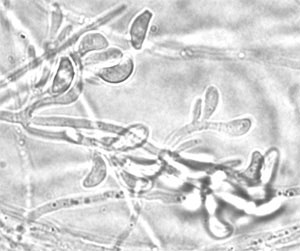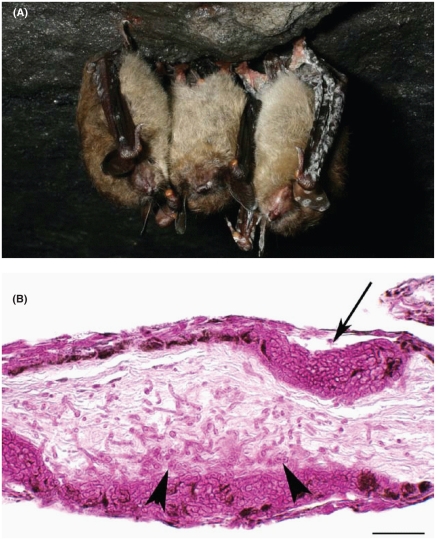Geomyces Destructans
A Microbial Biorealm page on the genus Geomyces Destructans

Classification
Kingdon: Fungi
Subkingdom: Dikarya
Phylum: Ascomycota
Subphylum: Pezizomycotina
Class: Leotiomycetes
Order: Helotiales
Family: Myxotrichaceae
Genus: Geomyces
Species: Geomyces destructans
Description and Significance

Geomices destructans is a fungus thought to be responsible for the large number of bat deaths in New England over the last several years. It first presented itself in the US in 2006 and then in Europe specifically France, in 2009. Until recently G. destructans was thought to be a normal resident inhabiting bats around the world. Further research links this to “white nose syndrome,” and even more recent research shows a 100% match between the DNA of G. destructans and the fungus found on the dead bats [1]. (Chaturvedi et al) Further study is needed on this subject; reachers do not seem to be sure if the fungus is stemming from pest control measures or how and why this has recently devastated bats around the world. Since first observation near Albany, NY in 2006, white nose syndrome has decimated populations of cave-hibernating bats in the northeastern United States, with mortality rates of 75-95%. In 2009, the infection area extended from northeastern New Hampshire to southwestern Virginia and expanded into Tennessee and Canada in 2010 [2]. Outside of North America, G. destructans has also been observed in colonized bats across Europe. It is not yet obvious how the infection is influencing the bat populations in Europe [10].
Genome Structure
The full DNA code for D.cinnamea has been partially sequenced and contains 3,555,295 bp (NCBI Nucleotide):[2].
D.cinnamea has a GC content of 72.3% (Von der Weid, 2006).
DNA of the P4 strain was sequenced with a 16S rDNA and it was found to have a 99.8% similarity to D.cinnamea that was found in the previous bone marrow transplant swab. When testing DNA-DNA similarities, the strains were 93.3% homologous with the transplant swab. A 70% threshold of DNA-DNA similarity is required to include it in the species. This confirms that P4 is part of the species D.cinnamea. This species has a 30-50% genome similarity with the other species of Dietzia (D.maris 52.4%, D.natronolimnaea' 56.3%, D.psychraicliphila 37.8%)(Figure 2)(Von der Weid, 2006).
Cell Structure and Metabolism

Bacilli are rod-shaped, Gram-positive, sporulating, aerobes or facultative anaerobes. Most bacilli are saprophytes. Each bacterium creates only one spore, which is resistant to heat, cold, radiation, desiccation, and disinfectants. Bacilli exhibit an array of physiologic abilities that allow them to live in a wide range of habitats, including many extreme habitats such as desert sands, hot springs, and Arctic soils. Species in the genus Bacillus can be thermophilic, psychrophilic, acidophilic, alkaliphilic, halotolerant, or halophilic and are capable at growing at pH values, temperatures, and salt concentrations where few other organisms can survive.
Ecology
Due to the metabolic diversity in the genus Bacillus, bacilli are able to colonize a variety of habitats ranging from soil and insects to humans. Bacillus thuringiensis parasitizes insects, and is commercially used for pest control. Although the most well known of the bacilli are the pathogenic species, most Bacillus are saprophytes that make their living off of decaying matter. Still others, namely Bacillus subtilis, inhabit the rhizosphere, which is the interface between plant roots and the surrounding soil. The plants roots and associated biofilm can have a significant effect on the chemistry of the soil, creating a unique environment.
It has recently been shown that Bacillus subtilis engages in cannibalism. They use cannibalism as the easy way out in extreme cases. For survival in harsh environments, bacilli can form spores, but it is very costly to them energy-wise. An easier way is for the bacteria to produce antibiotics that destroy neighboring bacilli, so that their contents may be digested allowing for the survival of a few of the bacteria. Essentially, what they are doing is snacking on their fellow bacilli, to tide them over, hoping for the environment to pick back up.
Pathology
Bacilli cause an array of infections from ear infections to meningitis, and urinary tract infections to septicemia. Mostly they occur as secondary infections in immunodeficient hosts or otherwise compromised hosts. They may exacerbate previous infection by producing tissue-damaging toxins or metabolites that interfere with treatment.
The most well known disease caused by bacilli is anthrax, caused by Bacillus anthracis. Anthrax has a long history with humans. It has been suggested that the fifth and sixth plagues of Egypt recorded in the Bible (the fifth attacking animals, the sixth, known as the plague of the boils, attacking humans). In the 1600s anthrax was known as the "Black bane" and killed over 60,000 cows. Anthrax has more recently been brought to our attention as a possible method for bioterrorism. The recent anthrax mailings have brought acute public attention to the issue and sparked extensive research into the devastating disease.
Anthrax is primarily a disease of herbivores who acquire the bacterium by eating plants with dust that contains anthrax spores. Humans contract the disease in three different ways. Cutaneous anthrax occurs when a human comes into contact with the spores form dust particles or a contaminated animal or carcass through a cut or abrasion. Cutaneous anthrax accounts for 95% of anthrax cases worldwide. During a 2-3 day incubation period the spores germinate, vegetative cells multiply, and a papule develops. Over the following days the papule ulcerates, dries and blackens to form the characteristic eschar. The process is painless unless infected with another pathogen.
Gastrointestinal anthrax is contracted by ingesting contaminated meat. It occurs in the intestinal mucosa when the organisms invade the mucosa through a preexisting lesions. It progresses the same way as cutaneous anthrax. Although it is extremely rare in developed countries, it has a very high mortality rate.
Pulmonary anthrax is the result of inhaled spores that are transported to the lymph nodes where they germinate and multiply. They are then taken into the blood stream and lymphatics culminating in systemic arthritis which is usually fatal.

Phages
Due to the danger of anthrax being used in biological weapons, research has been put into other methods, besides the highly controversial vaccine, to defend against the deadly disease. A recently discovered bacteriophage, the gamma phage, attacks Bacillus anthracis, and researches are optimistic about its clinical application. The bacteriophage is highly selective, and is extremely effective in lysing B. anthracis cells, while ignoring those of its closely related counterparts B. cereus and B. thuringiensis. The gamma phage has been over 80% effective in treating infected mice that were in the late stages of the disease, essentially rescuing them from almost certain death. There is the obvious concern that anthrax will develop strains that are immune to this treatment, and we will be right back where we started. Researchers say that this is unlikely because the only way to evade this predator would be a mutational change in cell wall structure to prevent the virus from binding, and this would kill the bacterium.
Medicine
Despite the pathogenic capabilities of some bacilli, many other species are used in medical and pharmaceutical processes. These take advantage of the bacteria's ability to synthesize certain proteins and antibiotics. Bacitracin and plymixin, two ingredients in Neosporin, are products of bacilli. Also, innocuous Bacillus microbes are useful for studying the virulent bacillus species that are closely related. B. subtilis has multiple carbohydrate pathways, representing the variety of carbohydrates found in the soil.
References
[[1] Chaturvedi V, Springer DJ, Behr MJ, Ramani R, Li X, et al. (2010) Morphological and Molecular Characterizations of Psychrophilic Fungus Geomyces destructans from New York Bats with White Nose Syndrome (WNS). PLoS ONE 5(5): e10783. doi:10.1371/journal.pone.0010783
[2] G. G. Turner, D. M. Reeder, and J. T. H. Coleman. 2011. A Five-year Assessment of Mortality and Geographic Spread of White-Nose Syndrome in North American Bats, with a Look at the Future. Update of White-Nose Syndrome in bats. Bat Research News, 52:13-27.pdf
[3] Gargas, A., M.T. Trest, M. Christensen, T.J. Volk, and D.S. Blehert. "Geomyces Destructans sp. nov. associated with bat white-nose syndrome." Mycotaxon 108.1 (2009): 147-54. Print.
[4] KUBÁTOVÁ1, ALENA, ONDŘEJ KOUKOL, ALENA NOVÁKOVÁ, and CZECH MYCOL. "Geomyces Destructans, Phenotypic Features of Some Czech Isolates." CZECH MYCOL 63(1): (2011): 65-75. Print.
[5] Courtin, F., WB Stone, G. Risatti, and K. Gilbert. "Pathologic Findings and Liver Elements in Hibernating Bats With White-Nose Syndrome." Veterinary Pathology. Veterinary Patholog, doi: 10.1177/0300985809358614 Mar. 2010. Web. 03 May 2012. <http://vet.sagepub.com/content/47/2/214.full>.
[6] Caspi et al., 2012, "The MetaCyc Database of metabolic pathways and enzymes and the BioCyc collection of pathway/genome databases", Nucleic Acids Research in publications resulting from its use. http://metacyc.org/ http://www.ncbi.nlm.nih.gov/ [7] Amy Whistle1, Evan Pannkuk2,3, David Gilmore1, Ellis Benjamin3, Earl Benjamin3, FATTY ACID METABOLISM BY GEOMYCES DESTRUCTANS. Department of Biological Sciences, Graduate Program in Environmental Science, Department of Chemistry and Physical Sciences Arkansas State University, State University https://ncur.weber.edu/ncur/archive/Display_NCUR.aspx?id=52845
[8]Wing pathology of white-nose syndrome in bats suggests life-threatening disruption of physiology. Paul M Cryan1, Carol U Meteyer2*, Justin G Boyles3 and David S Blehert.November 2010 [9]Serological, hematological and immunological research on hibernating bats. Jaeger R Experientia 1963, 19:596-598. [10] Wibbelt G, Kurth A, Hellmann D, Weishaar M, Barlow A, Veith M, Pruger J, Gorfol T, Grosche L, Bontadina F, et al: White-nose syndrome fungus (Geomyces destructans) in bats, Europe. Emerg Infect Dis 2010, 16:1237-1243.
Edited by student of Dr. Lisa R. Moore, University of Southern Maine, Department of Biological Sciences, http://www.usm.maine.edu/bio Category: Uncurated Pages

